Electric Fences: Managing Bears and Bees in Agriculture
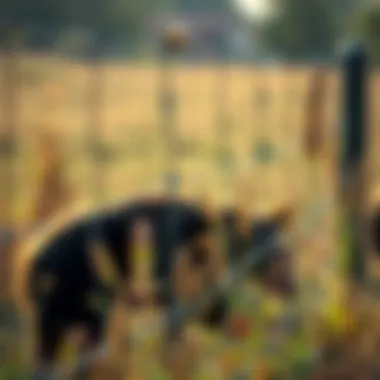
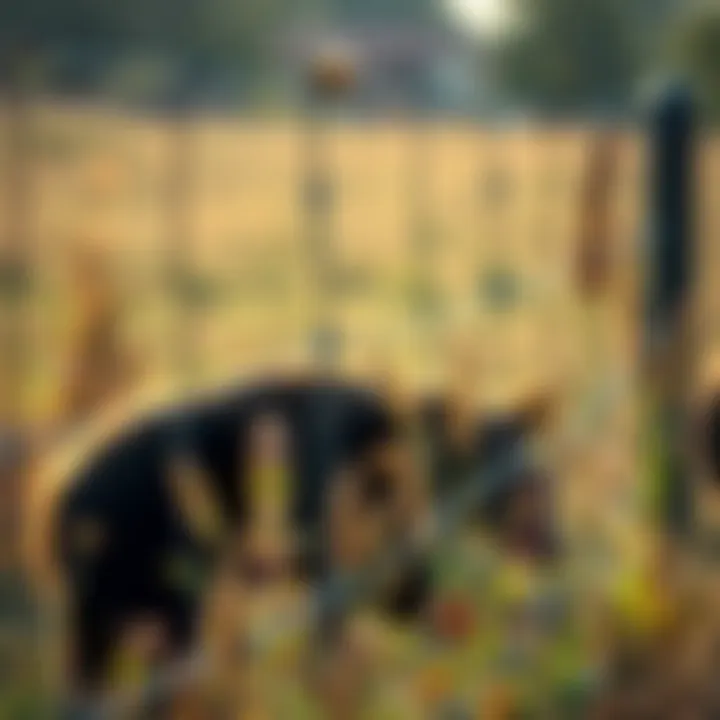
Key Insights
Understanding the dynamics between agriculture, wildlife, and technology is crucial for modern farmers. In particularly challenging environments, where crops are threatened by wildlife such as bears and bees are essential for pollination, integrating electric fencing provides a viable solution. This article examines how understanding animal behavior alongside technological advancements can help farmers protect their crops while simultaneously supporting essential bee populations.
Overview of the Topic
Electric fencing is a technology that has evolved not just for farm security but also for wildlife management. Farmers need to be aware of the habits and needs of both bears and bees. Bears are intelligent and can easily learn how to navigate around physical barriers, so an electric fence acts as a psychological deterrent. On the other hand, bees can be sensitive to their environment; thus, fencing must not interfere with foraging activities.
Importance in Agriculture/Horticulture/Agronomy
The significance of integrating electric fences into agricultural practices cannot be exaggerated. Crop loss due to wildlife incursions can devastate farmers, leading to financial setbacks. Simultaneously, bees require a habitat that is free from undue stress caused by predators. By applying electric fencing strategically, it protects crops from bears while not disrupting the bees’ foraging habits, thus addressing two issues at once. Farmers who implement these measures will likely see enhanced yield and healthier bee populations, promoting sustainable agricultural practices that benefit the ecosystem as a whole.
Sustainable Practices
Amid discussions about sustainability, it is vital to explore eco-friendly methods that farmers can adopt to better manage land and livestock. Electric fences stand out as an innovative solution that aligns well with sustainable agriculture.
Eco-Friendly Techniques
Using solar-powered electric fences, for instance, reduces reliance on power sources that can have larger ecological footprints. Other eco-friendly approaches include:
- Rotational grazing with electric fencing to allow fields to rest and recover.
- Natural barriers like bushes or trees that act as an additional line of defense while offering habitat for bees.
- Organic deterrents that can complement the presence of electric fences, providing additional layers of protection from bears without harming other wildlife.
Case Studies on Sustainability
Consider the case of a small organic farm in Vermont that faced repeated losses due to bear activity. By installing solar-powered electric fencing around their bee hives and vegetable patches, they observed a reduction in bear interactions. Not only were their crops more secure, but they noticed an uptick in bee activity due to the absence of bear predation. As noted in studies by the USDA, integrating such systems not only aids in wildlife control but can enhance pollinator activity, thus creating a thriving agricultural environment.
Tools & Resources
When considering the implementation of electric fencing, it’s essential to have the right tools and knowledge at hand.
Essential Equipment and Technologies
Here’s a quick rundown of the must-have equipment:
- High-tensile electric wire to ensure long-term durability.
- Solar energizers, which are effective even in remote areas without access to traditional electricity.
- Insulated posts to maximize voltage and minimize energy loss.
- Battery testers to ensure the system remains functional and effective.
Recommended Books and Readings
Imagine diving deeper into the matters of wildlife management and sustainable farming through various resources:
- "The Beekeeper’s Bible: Bees, Honey, and Wisdom" by Richard A. Jones.
- "Making the Most of Your Electric Fencing" available on agriculture-extension websites like USDA.gov or NRCS.
In rural farming communities, electric fencing has proven to be both a protective measure against bears and an ally for beekeepers, merging their goals to secure crops and sustain bee populations.
In sum, by exploring sustainable practices through electric fencing, farmers can better manage their agricultural endeavors and align with ecological principles. The integration of these systems not only protects crops but also provides a safe environment for bees, underscoring the intersection of technology and eco-conscious farming.
Understanding Electric Fencing
Electric fencing has become an essential tool in modern agriculture, especially for farmers needing to protect their crops from wildlife and maintain the delicate ecosystem. In this context, integrating electric fences plays a crucial role in managing bear and bee populations. Understanding how electric fencing works and its components is fundamental for successful implementation in agricultural settings.
What is Electric Fencing?
Electric fencing refers to a barrier that uses electrical energy to deter animals from crossing its boundaries. This type of fencing operates on the principle of delivering a brief electric shock to animals that come into contact with it, creating a psychological barrier that typically keeps them away. For farmers dealing with the dual challenge of bears encroaching on crops and bees needing protection, electric fencing serves as a reliable, humane, and effective solution.
Components of Electric Fencing
Understanding the components of electric fencing is critical for ensuring its effectiveness. Four main components play vital roles in the system: fence energizers, conductors, insulators, and grounding systems. Each contributes uniquely to enhancing the performance of electric fences.
Fence Energizers
Fence energizers, also known as energizers or chargers, generate the electric pulse that travels along the wires of an electric fence. A key characteristic of energizers is their capability to produce high-voltage pulses while consuming relatively low amounts of energy. This makes them an economical choice for those managing larger agricultural areas. The unique feature of energizers is the ability to adjust pulse intensity based on the environment and the specific needs of both crops and wildlife. Their advantages include ease of installation, adaptability to various terrains, and a reliable power source that ensures the system's long-term functionality. However, it’s essential to choose the correct energizer based on the size of the fenced area and the type of animals being managed.
Conductors
Conductors are the actual wires that carry the electric current throughout the fence. These often made from materials like galvanized steel, aluminum, or copper, are crucial for transmitting the electrical pulse effectively. A key feature of conductors is their conductivity and strength; they must withstand environmental stress while maintaining good electrical flow. They are popular choices for electric fencing due to their durability and resistance to rust and corrosion, which is particularly important in agricultural settings where exposure to moisture is common. Unique to conductors is that they need to be well-placed to ensure a uniform electric field, meaning farmers must consider spacing and height carefully. On the downside, if not properly maintained, conductors can suffer from rust, diminishing their effectiveness.
Insulators
Insulators ensure that the electric current only flows through the conductors and does not escape to the ground or surrounding structures. They serve as a barrier between the conductor and the fence posts, which might otherwise conduct the electricity. An essential characteristic of insulators is their ability to withstand high voltage without breaking down. They are crucial for reducing the risk of unwanted shocks to livestock or humans. The standout feature of quality insulators is that they should be resistant to weather elements and UV light, ensuring longevity in diverse conditions. The advantage of using proper insulators is that they significantly increase the lifespan of the fencing system. Poor insulator choices can lead to energy loss and potential safety hazards.
Grounding Systems
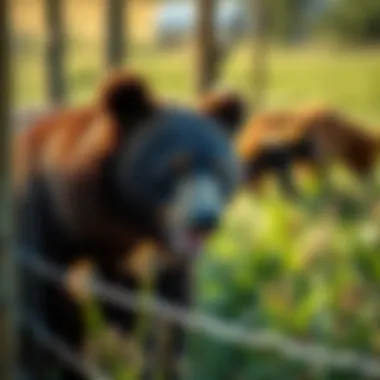
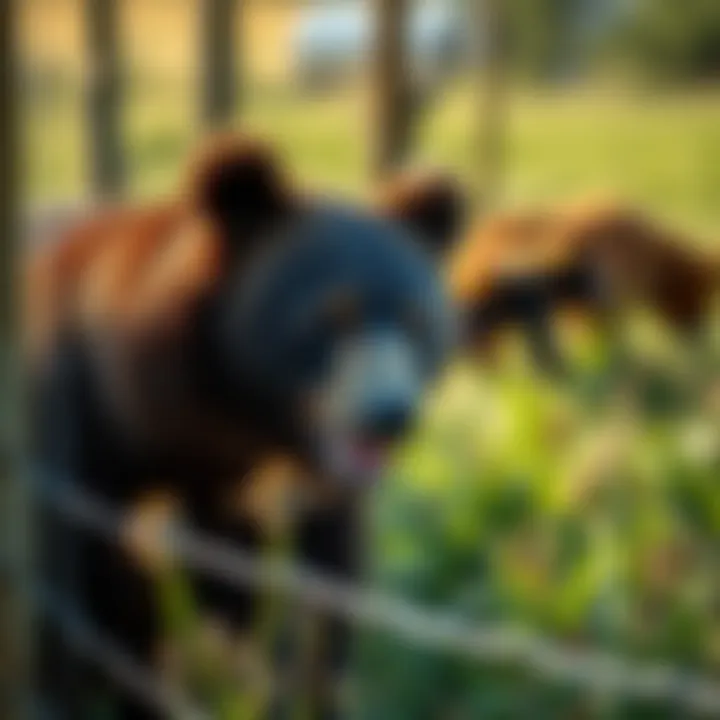
Grounding systems are pivotal for completing the electric circuit and ensuring the effectiveness of the electric fence. They typically consist of grounding rods driven into the earth, allowing excess electricity to dissipate safely. A key characteristic of grounding systems is that they need to be properly installed and placed in moist soil for optimal performance. Farmers often find grounding systems to be beneficial because they enhance the effectiveness of the electric pulses, making the system more reliable. The unique feature of grounding systems is their role in preventing electrical surges and ensuring consistent voltage. However, improper grounding can lead to ineffective fencing and risks to animal safety.
Integrating electric fencing into agricultural practices can protect crops and manage bear activities while ensuring ecological balance. By understanding electric fencing components, farmers can create systems that effectively address the challenges posed by wildlife while keeping bee populations thriving.
Behavioral Patterns of Bears
Understanding the behavioral patterns of bears is crucial in devising effective strategies for managing their interactions with agricultural practices. Bears, while often seen as majestic creatures of the wild, pose unique challenges when they venture into farming areas. Their behaviors—shaped by instincts and environmental factors—can lead to significant crop damage and economic losses for farmers. Recognizing these patterns aids in implementing solutions that protect crops while maintaining the delicate balance necessary for sustaining wildlife.
Bears in Agricultural Areas
Bears, particularly the black and grizzly species, are increasingly found in agricultural zones as they search for food. This shift is driven by several factors including habitat loss and changes in natural food availability. In agricultural areas, bears may explore fields for easily accessible food sources like berries, corn, and other crops. Understanding their adaptations to human-dominated landscapes can guide farmers in choosing effective intervention tactics.
- Food Attraction: Bears are opportunistic feeders, drawn to high-calorie food sources. When they find crops abundant, their likelihood of return also increases, making it imperative for farmers to be proactive in managing attractants.
- Seasonal Patterns: The seasons influence bear behavior and their interaction with human activities. Farmers should adjust their strategies according to these seasonal changes to minimize conflicts and protect their livelihood.
Feeding Habits and Seasonal Behavior
Bears exhibit varied feeding habits influenced by the seasons, which defines their interactions with agricultural crops.
Seasonal dietary preferences
Seasonal dietary preferences refer to the specific foods that bears choose to eat at different times of the year. In spring, for instance, bears might prefer tender new shoots and grasses, while summer often leads them to berries.
- Key characteristic: During autumn, bears consume large amounts of food in preparation for hibernation, seeking out high-energy foods such as apples or corn in orchards or fields. This stage is vital as it often overlaps with harvest periods, increasing the chance of human-bear conflicts.
- Unique feature: Each season brings distinct food preferences, making agricultural areas attractive during specific times. This behavior can be beneficial for farmers looking to understand peak times for bear activity, allowing them to implement protective methods accordingly.
Grazing vs. scavenging behavior
Bears are also known for their grazing and scavenging behavior, which reflects their versatility in food acquisition strategies. Grazing, typically observed in pastures or meadows, involves actively consuming live vegetation, while scavenging involves searching for carrion or already decayed food sources.
- Key characteristic: Grazing may contribute positively to agricultural ecosystems by managing weed growth, whilst scavenging often leads to conflict with human settlements if not managed properly.
- Unique feature: Though both behaviors are natural to bears, the shift towards scavenging in human-populated areas raises concerns about their safety and the potential for property damage.
Bear Proximity and Human Interaction
As bears become more active and venture closer to human settlements, their proximity raises issues that necessitate attention.
Conflict zones
Conflict zones are geographical areas where human activities overlap with bear habitats, often leading to confrontations. For farmers, understanding these zones can aid in mitigating conflicts.
- Key characteristic: Areas near abundant food sources, such as fruit orchards or feed storage, are souces of consistent bear activity. Recognizing these hotspots allows farmers to strategize more effectively.
- Unique feature: Mapping conflict zones may inform interventions like electric fencing, deterring bears without harming them or reducing agricultural productivity.
Preventative measures
Preventative measures are strategies put in place to deter bears from agricultural zones and interactions with humans. From securing waste to understanding bear behavior, these measures are essential for farmers.
- Key characteristic: Implementing measures like electric fencing not only reduces potential crop loss but also protects bear populations by limiting their access to human food sources. This is crucial in maintaining a balance between crop protection and wildlife conservation.
- Unique feature: Each preventative measure can be fine-tuned based on local bear populations and behaviors, making them adaptable to specific farming conditions.
Understanding the behavioral patterns of bears is a foundational step in integrating electric fencing effectively and sustainably in agriculture, ensuring that both farmers and bears coexist with less conflict.
Understanding Bees in Agriculture
Bees are far more than a simple buzz in the garden; they play a critical role in agriculture, directly influencing food production and ecosystem health. This section delves into the significance of bees, especially within the context of integrating electric fencing for managing both bears and bees in agricultural settings. The health and stability of crops primarily hinge on effective pollination, a natural service essential to many plants that provide fruits, vegetables, and nuts.
The Role of Bees in Ecosystems
Pollination benefits
Pollination is the lifeblood of numerous agricultural systems. It involves transferring pollen from one flower to another, facilitating the fertilization process necessary for fruit and seed production. Bees are among the most efficient pollinators, often ensuring better yield and fruit quality compared to self-pollinating plants or wind-pollination. Farmers need to realize that having healthy bee populations can lead to an increase in yield ranging from 30 to 60 percent in various crops.
The unique characteristic of bees is their foraging behavior; they collect nectar and pollen from a vast range of flowers, thus promoting genetic diversity among plants. This is vital for ecosystem resilience. In the context of this article, discussing pollination highlights why safeguarding bee populations through appropriate management strategies, such as electric fences, is paramount. However, it's crucial to consider the potential side effects of electric fencing on bee activity and ensure that we incorporate fencing designs that minimize disruption.
Biodiversity contributions
Bees contribute significantly to biodiversity, serving as intermediaries between different plant species and helping ecosystems thrive. This interdependency sustains not only crop production but also wild flora and fauna. Healthy populations of bees help maintain the balance of ecosystems, thereby supporting various life forms, including other pollinators and insects.
The remarkable feature of bees is their ability to adapt to various environments. By creating habitats where flowers bloom throughout the seasons, farmers can support not just bees but also other wildlife, leading to improved ecological health. Therefore, emphasizing biodiversity through electric fencing considerations can appeal to a broader audience concerned about ecological footprints while still addressing agricultural needs. Crafting solutions that integrate habitat conservation into fencing practices can be beneficial for both bees and crop protection.
Common Threats to Bees
Threats to bee populations are numerous and varied, some stemming from human activity. Recognizing these risks is essential for developing responsible management practices that protect both crops and bee health.
Pesticides
Pesticides pose a significant risk to bee populations. Chemicals designed to protect crops can also harm unintended targets, including beneficial insects. The important aspect is understanding the effects of certain pesticide classes, such as neonicotinoids, that disrupt bee navigation and can lead to population declines.
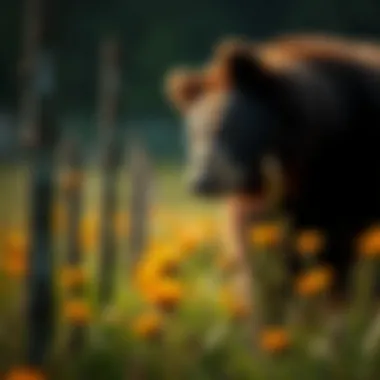
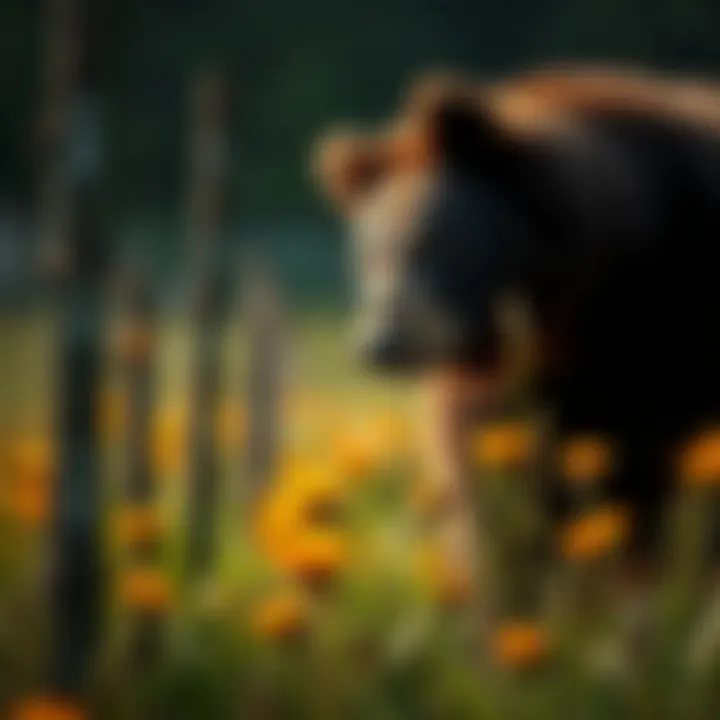
In this article, the discussion on pesticides becomes crucial when considering how electric fencing affects bee behavior. Using integrated pest management (IPM) techniques alongside electric fencing ensures that we can safeguard crops from pests while also promoting pollinator health. Avoiding the use of pesticides during peak bee activity is one strategy farmers can adopt to mitigate risks.
Habitat loss
Habitat loss is another critical factor contributing to declining bee populations. Urbanization, monoculture farming, and pesticide use have led to a significant decrease in wildflower habitats, which are vital for bees. This loss diminishes the food sources available for both wild and domesticated bees.
Highlighting habitat restoration efforts in conjunction with electric fence installation can create a more sustainable agricultural ecosystem. Encouraging farmers to plant native flowers around electric fences not only beautifies the landscape but also provides essential food sources for bees and potentially improves crop pollination.
Diseases
Bee diseases and parasites present yet another threat. Varroa mites and Nosema are examples of organisms that weaken and decimate bee colonies. The discussion around diseases is particularly relevant when implementing electric fencing since changes in local wildlife dynamics could either promote or inhibit disease spread among local bee populations.
Understanding these threats allows farmers to create a more informed strategy when deciding how to integrate electric fencing systems. Developing protocols for monitoring bee health and being proactive about disease management cannot be overlooked in any agricultural setting where bees are essential.
Bees Around Electric Fences
It’s vital to ensure that electric fencing serves its purpose without jeopardizing bee populations. Thoughtful design and placement of fences can minimize potential harm to these important pollinators.
Electric fence design considerations
When choosing to install electric fencing for bear management, specific design considerations must be kept in mind concerning bees. For instance, making sure the fencing is strategically placed to avoid direct contact with flowering plants can help reduce accidental harm. The fence height and electrification levels should also be evaluated to ensure they don’t interfere with bee foraging patterns.
A well-constructed electric fence design not only keeps bears away but can also serve as a buffer for bee habitats. Ensuring that areas remain wildlife-friendly through design innovations can address the needs of both bears and bees, promoting coexistence in agricultural landscapes.
Minimizing bee harm
To further reduce the risk of harming bees, farmers can implement features that are beneficial for bees while maintaining the fence’s effectiveness against bears. For instance, using non-harmful materials and grounding systems can deter electric shock, creating a safer environment for bees.
The unique advantage of adopting these strategies is that farmers can maintain productivity and still support pollinators. Implementing non-invasive fencing designs and actively managing bee populations through habitat considerations can yield benefits that extend beyond mere crop protection.
In summary, understanding bees' vital roles in agriculture and their surrounding ecosystem is imperative for farmers. By integrating electric fencing thoughtfully, we can protect crops from bears while simultaneously ensuring our bee populations thrive.
Integrating Electric Fences into Bear Management
In the evolving world of agriculture, safeguarding crops against wildlife, particularly bears, has become paramount. Utilizing electric fencing is one of the most effective methods of managing bear interactions with farmland. Bears, while majestic creatures, can wreak havoc on crops when they venture too close to human habitation. Implementing electric fences allows farmers not only to protect their produce but also to promote a harmonious coexistence with the local wildlife.
The integration of electric fences serves multiple purposes — deterring bears from accessing fields, reducing crop damage, and ultimately aiding in ensuring food security. A well-designed electric fencing system can act as a psychological barrier for bears, enticing them to stay away from agricultural zones. By integrating electric barriers into bear management strategies, farmers can alleviate concerns over losses, enabling them to focus more on sustainable agricultural practices and less on constant vigilance.
Best Practices for Electric Fencing Against Bears
Optimal height and spacing
When we talk about optimal height and spacing for electric fences, it’s about finding that sweet spot that effectively keeps bears at bay. Generally, a fence should stand around 3 to 5 feet tall, depending on the specific bear species in the area. Sufficient spacing between wires is also crucial; about 8 to 12 inches between them often does the trick. Bears are curious and can easily try to squeeze through tight spaces, so ensuring that the distance is adequate will intercept any adventurous bear attempting a climb.
The characteristic that makes this height and spacing beneficial is its ability to deter bears without being overly restrictive to other wildlife. Too high or too wide could be a problem. A fence that’s too tall might be an eyesore, whereas one that’s too low could easily become a climbing opportunity. It’s a balancing act—this optimal height and spacing not only designed to be sufficient for bear deterrence but also minimizes potential hazards for bees and other harmless species, promoting a greater level of ecological consciousness.
Strength of the pulse
Next on the docket is the strength of the pulse delivered by the energizer. An electric fence needs a pulse that packs a punch to effectively deter bears. Typically, the pulse voltage should be between 5,000 to 10,000 volts; this pulse intensity is usually effective enough to teach bears to respect the boundary.
The key advantage of having a strong pulse is that it creates a lasting impression. One zap can be enough to get a bear to think twice before approaching again, particularly if they associate the electric shock with their previous encounters. However, it is important to regularly check and maintain the strength to ensure that it is functioning adequately because any lag in pulse strength could be inviting trouble.
When configuring the pulse strength, it's essential to adhere to recommended guidelines. If the voltage is too high, it could become detrimental, potentially harming not only bears but also non-target wildlife, including domestic animals and even bees that frequent the vicinity. The balance here is vital for ensuring wildlife management aligns with ecological preservation.
Safety Measures for Electric Fencing
Safety is a non-negotiable aspect of integrating electric fences into bear management. While these fences serve as protective barriers, they must also consider the welfare of all creatures involved: from farmers to bears to bees.
- Signs and Notifications: It's crucial to mark electric fences clearly with warning signs. This helps inform not only potential trespassers but also neighbors and passersby, ensuring everyone is aware of the present boundaries.
- Regular Maintenance: Inspecting the condition of wires and checking the power source regularly is fundamental to ensure the fence operates correctly. If vegetation grows over the wires or connections weaken, the fence may not deliver the intended shock.
- Bear-Proofing: Implementing additional measures such as bear-proof gates can enhance the safety and efficacy of electric fencing. This adds a layer of protection, making it more difficult for a bear to bypass the electric barrier.
- Low-Impact Solutions: While securing crops, it’s also wise to include technologies like solar energizers that minimize environmental impact. This approach complements electric fencing by ensuring sustainability while managing wildlife interactions effectively.
By integrating these practices and safety measures, farmers can foster a more sustainable agricultural practice while coexisting with the wildlife around them. In essence, electric fencing can alleviate the tensions that arise from shared land use, embodying a blend of protection and coexistence.
Bees and Electric Fences: Coexistence Strategies
Integrating electric fences in agricultural settings brings unique challenges and opportunities, especially regarding the wellbeing of both bears and bees. Understanding how these two elements can coexist harmoniously is essential for sustainable farming practices. The strategic implementation of electric fences not only prevents bears from obstructing crops but also considers the intricate lives of bees that are paramount to pollination and ecosystem health.
Designing Bee-Friendly Electric Fences
Careful Material Selection
When planning electric fencing systems, the choice of materials is crucial. Using non-toxic and environmentally friendly materials can significantly contribute to reducing the risk of harming bee populations. For instance, choosing UV-resistant polymers for insulators not only ensures durability but also minimizes chemical leaching into the soil. This approach allows farmers to safeguard both crops and bees effectively. Also, selecting smooth conductors, like stainless steel or high-quality aluminum, helps to prevent bee entanglement, which can be harmful and disruptive.
Such intentional selection promotes a healthier ecosystem around the farm. While slightly more expensive, these materials ultimately lead to fewer adverse interactions with pollinators, ultimately benefiting harvests.


Placement Considerations
Placement of electric fences plays a pivotal role in their effectiveness and safety for bees. Positioning fences away from high bee traffic zones, such as flowering crops or known nests, can significantly reduce bee stress and accidental shock incidents. This thoughtful arrangement ensures that the fences serve their primary function—dissuading bears—without obstructing bees' natural behaviors.
Moreover, maintaining a distance creates a buffer zone which can protect both the plants and the pollinators. In addition, farmers should aim to erect fences at a height that deters larger animals without interfering with bee flight paths. The longer-term benefits include enhanced pollination rates and, thus, greater productivity.
Electric Fencing Impact on Bee Behavior
The direct effects of electric fencing on bee behavior merit detailed examination. Observational studies suggest that bees exhibit altered flight patterns when near electric fences, often becoming more cautious. They may avoid these areas altogether, which can lead to reduced pollination within certain crop regions. Understanding these patterns is vital for farmers who are looking to minimize disruptions.
In addition, the electromagnetic fields generated by electric fences could potentially influence bee navigation. Research seems to indicate that while bees are quite resilient, excessive exposure to strong electromagnetic fields may lead to disorientation. Thus, it is imperative for farmers to integrate monitoring systems and feedback loops that allow adjustments based on bee activity around these fences.
"Strategic design and placement of electric fences ensure farmers protect their crops while fostering a thriving environment for bees."
Regulatory and Ethical Considerations
Integrating electric fences in agricultural practices, especially for managing bear and bee interactions, isn't just about setting up the right technology. There’s a tapestry of regulatory and ethical considerations that farmers and enthusiasts must weave through their strategies. These considerations ensure compliance with regional laws and foster an ethical approach to wildlife management.
Laws Governing Electric Fences
Regional regulations
Regional regulations play a fundamental role in influencing how electric fencing can be implemented in agricultural settings. Different areas have their own specific laws and guidelines that dictate how fences can be constructed, maintained, and monitored. One key characteristic of these regulations is their focus on safety, both for livestock and for wildlife. Compliance with these rules ensures that farmers avoid potential legal repercussions while also promoting animal welfare.
It's often a beneficial choice for farmers to familiarize themselves with their local laws, as these regulations can provide useful guidance on best practices while discouraging harmful practices. For example, some regions require that electric fences be designed to minimize risks to non-target species like bees and other pollinators or even domestic animals. This unique feature of regional regulations not only protects wildlife but can also enhance a farmer's reputation in the community and amongst consumers.
However, regional regulations can also have disadvantages. Restrictions may limit the types of materials that can be used or the height of fences, which can hinder a farmer's ability to tailor solutions to their specific needs. Moreover, navigating through various local statutes can be daunting and time-consuming.
Best practices compliance
Best practices compliance refers to the adoption of established guidelines that help ensure the safe and effective use of electric fences. This involves following recommended heights, spacing, and electrical pulse strength when setting up electric fencing. The primary characteristic of best practices compliance is its dual focus on efficacy and safety, offering farmers a way to safeguard their crops while mitigating risks to wildlife.
Embracing best practices is often a popular choice amongst farmers looking to enhance their compatibility with both bears and bees. The unique feature here is the emphasis on sustainable approaches that blend modern agricultural needs with ecological considerations. This compliance can lead to increased efficiency in bear management and decreased fatalities among surrounding bee populations.
On the downside, adhering to best practices may involve an upfront investment of time and money that some may find burdensome, particularly for small-scale farmers. Nonetheless, the long-term benefits typically outweigh these initial hurdles by fostering healthier ecosystems and sustainable agricultural practices.
Ethical Aspects of Wildlife Management
Balancing protection and intrusion
In the realm of wildlife management, striking a balance between protection and intrusion is pivotal. This aspect emphasizes the need for farmers to protect their crops and livelihood without encroaching on the natural habitats and behaviors of wildlife. The main characteristic of striking this balance is its sensitivity to both sides of the equation—agricultural productivity and wildlife conservation.
A thoughtful approach here is crucial. It’s undeniably a beneficial practice for farmers to employ strategies that deter bears from invading their crops without causing harm or distress to the animals. The unique feature of this approach lies in adopting strategies such as using natural repellents along with fencing. This ensures the agricultural ecosystem remains intact while providing a protective barrier for crops.
However, consciously navigating this balance can lead to ethical dilemmas. Farmers often wrestle with the decision of how far to go in protecting their crops when it may mean risking bear populations or altering their natural patterns.
Preserving ecological integrity
Preserving ecological integrity is integral to the sustainability of both crops and wildlife. This aspect addresses the intricate relationships that exist within ecosystems. By ensuring that electric fences allow for safe passage and maintained habitats for wildlife, farmers can contribute to the overall health of their local environments. The key characteristic here is the recognition of interconnectedness—what benefits one part of the ecosystem supports others.
This choice is often seen as favorable since it aligns agricultural practices with broader ecological goals, such as biodiversity and environmental stewardship. The unique feature is how the thoughtful placement and design of electric fences can reduce habitat fragmentation, allowing bees and bears to thrive alongside farming activities.
On the downside, this requires a conscious commitment to long-term ecological health, which may at times conflict with immediate agricultural goals. Farmers may feel torn between short-term productivity and the long-term preservation of ecological balance.
"In choosing paths for electric fencing, a farmer must walk the fine line of safeguarding crops while nurturing the land that sustains them."
In summary, regulatory and ethical considerations are paramount for farmers employing electric fences for bear and bee management. Navigating these waters carefully allows for effective crop protection while promoting sustainability and ecological integrity.
Finale: The Future of Electric Fencing in Agriculture
The integration of electric fencing in agricultural practices presents both a challenge and an opportunity. As farmers and enthusiasts, understanding the potential of this technology can be the key to enhancing productivity and sustainability in the face of increasing wildlife encounters. Unlike traditional fencing methods, electric fences provide an adaptable solution for keeping bears at bay without compromising the delicate balance needed for bee populations.
Emerging Trends in Fencing Technology
The evolution of fencing technology continues to shape how farmers approach wildlife management. Here are some current trends that are making waves:
- Solar-Powered Energizers: With the rise in sustainable energy solutions, solar-powered electric fence energizers have become popular. They function efficiently in remote areas where traditional power sources aren’t available, allowing for flexibility in fence placement without the hassle of wiring.
- Smart Monitoring Systems: Technology is advancing toward smarter fencing with real-time monitoring systems. Sensors can alert farmers via smartphone notifications when the fence is breached or when battery levels are low. This feature maintains the integrity of the fence and minimizes potential losses.
- Environmentally Friendly Fencing Materials: Farmers are increasingly considering eco-friendly materials for electric fences. Biodegradable insulators and corrosion-resistant conductors are hitting the market, providing options that align with conscious farming practices. "Keeping the land green shouldn't come at the cost of protecting crops," is a commonsense perspective that more farmers are taking to heart.
This ebb and flow of innovation ensures that electric fencing is not only effective but also conducive to modern agricultural practices. Farmers wanting to stay ahead need to embrace these up-and-coming technologies.
The Role of Community in Sustainable Practices
Farming doesn't occur in isolation. The role of community in adopting sustainable practices is paramount. Here’s how the connection can be fostered:
- Shared Knowledge and Resources: Local farming communities can benefit from information exchanges concerning the best practices of electric fencing. Workshops and seminars may serve as platforms for sharing advice on layout, materials, and experiences.
- Collective Purchasing Power: By pooling resources, farmers can negotiate better deals on electric fencing materials and technology. This collective bargaining fosters a spirit of camaraderie while ensuring all members get access to high-quality materials at reduced costs.
- Advocacy for Policy Change: Communities can work together to influence agricultural policies at local and regional levels. Highlighting the benefits of using electric fences for wildlife management might lead to easier access to subsidies and grants.
- Engaging in Local Conservation Efforts: Farmers can collaborate with environmental groups to promote coexistence strategies. These partnerships create a network of support and collective action towards achieving a sustainable agricultural environment.
The involvement of the community not only strengthens individual efforts but also enhances the overall health of the agricultural landscape.
"In unity, there is strength." This age-old adage rings true as communities band together to adopt innovative solutions for today’s farming challenges.







